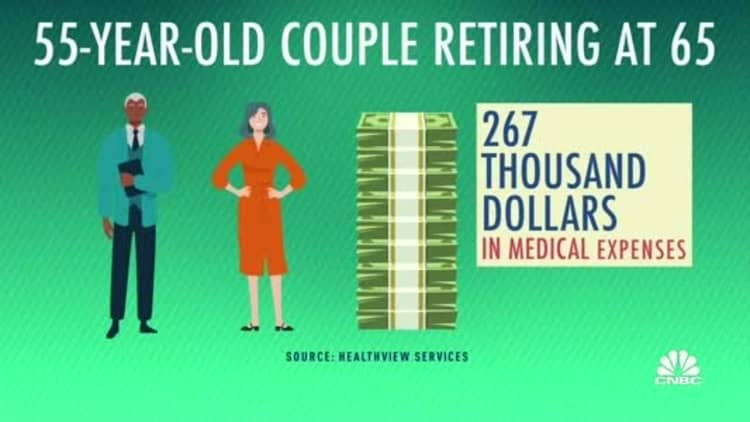Shapecharge | E+ | Getty Images
If you’re a higher-income Medicare beneficiary, you may be paying less in extra premium charges in 2023 than you were this year.
So-called income-related adjustment amounts, or IRMAAs, which are based on your tax return from two years earlier, kick in next year at $97,000 for single tax filers and $194,000 for joint filers (based on their 2020 return), up from $91,000 and $182,000, respectively.
Additionally, with the standard Part B (outpatient care coverage) premium dropping by 3% next year to $164.90 from $170.10 in 2022, the IRMAAs also are less costly.
The surcharges apply to both Part B and Part D (prescription drug coverage) premiums and affect about 7% of Medicare’s 64.3 million beneficiaries. The higher your income, the higher the charge. (See charts below.)
Whether you have to pay the surcharge is based on your modified adjusted gross income as defined by the Medicare program: your adjusted gross income plus tax-exempt interest income.
“You only have to go $1 over that [lowest] breakpoint and you’re subject to IRMAAs,” said certified financial planner Barbara O’Neill, owner and CEO of Money Talk, a financial education company.
“If you’re close to that or close to going to a higher tier, you’ve really got to be proactive,” O’Neill said.
In other words, there are some strategies and planning techniques that can help you avoid or minimize those IRMAAs. Here are four to consider:
1. Focus on income streams under your control
While some income in retirement is generally set — i.e., Social Security and/or a pension — the key to avoiding IRMAAs is to focus on what income streams you can control, said CFP Judson Meinhart, senior financial advisor and manager of financial planning for Parsec Financial in Winston-Salem, North Carolina.
“The key to keeping [your income] below the IRMAA brackets is planning ahead to know where your income is coming from,” Meinhart said.
Be aware that the IRMAA determination is typically based on your tax return from two years earlier. If your income has dropped since then, you can appeal the IRMAA decision using Form SSA-44 and providing proof that you’ve experienced a “life-changing event” such as retirement, death of a spouse or divorce.
2. Consider Roth IRA conversions
One way to keep your taxable income down is to avoid having all of your nest egg in retirement accounts whose distributions are taxed as ordinary income, such as a traditional IRA or 401(k) plan. So whether you’ve signed up for Medicare yet or not, it may be worth converting taxable assets to a Roth IRA.
Roth contributions are taxed upfront, but qualified withdrawals are tax-free. This means that while you would pay taxes now on the amount converted, the Roth account would provide tax-free income down the road — as long as you are at least age 59½ and the account has been open for more than five years, or you meet an exclusion.
“You pay a little more now to avoid higher tax brackets or IRMAA brackets later on,” Meinhart said.
It also helps that Roth IRAs do not have required minimum distributions, or RMDs, in the owner’s lifetime. RMDs are amounts that must be withdrawn from traditional IRAs, as well as both traditional and Roth 401(k) accounts, once you reach age 72.
When RMDs from traditional accounts kick in, your taxable income could be pushed up enough that you become subject to IRMAAs, or to a higher amount if you already were paying the surcharge.
“A lot of people get into trouble by taking no money out of their 401(k) plan or IRA, and then they have their first RMD and it puts them in one of those IRMAA brackets,” Meinhart said.
3. Keep an eye on capital gains
If you have assets that could generate a taxable profit when sold — i.e., investments in a brokerage account — it may be worth evaluating how well you can manage those capital gains.
While you may be able to time the sale of, say, an appreciated stock to control when and how you would be taxed, some mutual funds have a way of surprising investors at the end of the year with capital gains and dividends, both of which feed into the IRMAA calculation.
“With mutual funds, you don’t have a whole lot of control because they have to pass the gains on to you,” said O’Neill, of Money Talk. “The problem is you don’t know how big those distributions are going to be until very late in the tax year.”

Depending on the specifics of your situation, it may be worth considering holding exchange-traded funds instead of mutual funds in your brokerage account due to their tax efficiency, experts say.
For investments whose sale you can time, it’s also important to remember the benefits of tax-loss harvesting as a way to minimize your taxable income.
That is, if you end up selling assets at a loss, you can use those losses to offset or reduce any gains you realized. Generally speaking, if the losses exceed the profit, you can use up to $3,000 per year against your regular income and carry forward the unused amount to future tax years.
4. Tap your philanthropic side
If you’re at least age 70½, a qualified charitable contribution, or QCD, is another way to keep your taxable income down. The contribution goes directly from your IRA to a qualified charity and is excluded from your income.
“It’s one of the few ways you can really get money out of an IRA completely tax-free,” Meinhart said. “And when you’re 72, that charitable distribution can help offset your required minimum distributions.”
The maximum you can transfer is $100,000 annually; if you’re married, each spouse can transfer $100,000.
 EU News Digest Latest News & Updates
EU News Digest Latest News & Updates



